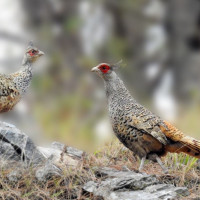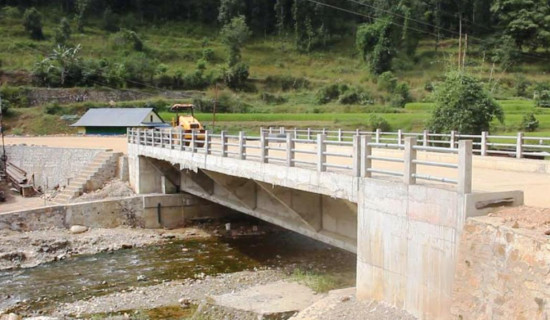- Saturday, 29 November 2025
Langtang Valley: An Astounding Destination
Langtang Valley is very popular among the trekkers because of a marvelous and scenic destination. It lies in Gosainkunda Rural Municipality Ward No-4 of Rasuwa District in Bagmati Province, Nepal. It is the main panoramic world of Langtang National Park spreads at the height of 3870 metres from the sea level,. There are mainly two human settlements around the snow valley; Langtang village (3430 m) and Kyanjing Gompa (3870m). The valley is also known as Kyanjing Gompa which is surrounded by snow-capped mountains. Glaciers, rivers, rivulets, flat land, alpine vegetation and gompas, monasteries, chortens, manees, cultural fairs and colourful flags make the valley amazing and stunning. It is one of the best choices of trek lovers of the world. Kyanjing Gompa offers an exceptional excitement for both trekkers and spiritual seekers as well.
Langtang Valley is accessible for experiencing the Himalayan flora, founa, unique landmark and distinct cultural heritages. The valley rewards the trekkers a wide range of trekking opportunities from one day hikes to multi-day treks, with incredible experiences.
The nearest motorable road heads for the Langtang Valley is only to Syaphrubesi, the base for most treks to the Langtang Valley and other several destinations. Travllers who leave for Syaphrubesi, should move on 117 kilometres through roadway from Kathmandu. Due to fine tarred road, drive normally takes five to six hours from Kathmandu to Syaphrubesi. Nowadays, as the visitors’s choice, luxury buses, micro-vans and jeeps are making one’s journey joyous. From Syaphrubensi Bazaar, no other options to the valley except moving on foot and it may take two days. As per the government rules, for entering Langtang National Park and Langtang Valley requires everyone except locals to have the TIMS permit and the Langtang National Park entry permit.
Since it lies within the Himalayan region, it is famous for wide variety of climatic zones, from subtropical to alpine. On the way, trekkers enjoy variety of trees include the deciduous oak and maple, evergreen plants like pine, and various types of rhododendron trees. Fortunate trekkers can see wild animals like Himalayan black bear, boar, Himalayan tahr, Red monkey, languer assamese macaque, snow leopard, yak, red panda and birds like lophophorous, doves, francolins etc.
Langtang village, the main residence of the local people, is situated beneath Mt. Langtang Lirung. Most of the locals follow Buddhism and speak the language that is closely related to the Tibetan spoken in adjoining area of China. The traditional livelihood of the local people have centered around agropastoralism. Since the mid-1970s, tourism had begun gearing up and became a major source of living in Langtang Valley. On these days, more than forty and fifty hotels, lodges and guesthouses are offering the worldclass services to the trekkers at Langtang village and Kyanjing Gompa respectively. The Langtang Valley trek, from Syaphrubesi to Kyanjing and back, is accepted as the third popular trek in the country, after the Annapurna Circuit and Everest Base Camp treks.. Nepal Telecomminication Company has recently launched 4G technology for easy telephone and internet services in the valley.
Langtang Valley is rich in cultural celebrations, with several festivals such as Lhosar, Tarna Festival, and Janai Purnima, Dawa Dangpo, Tsechu and fairs. Another attraction at Kyanjing is cheese factory, established in 1952.
Several treks takes place through the Langtang Valley linking to Helambu, Sundarijal, Gosainkunda, Tamang Heritage trail, Parbatikunda and many others. In most of these treks, one can dine at local 'tea houses, restaurants and stay overnight in hotels, guesthouses which are run by locals in the valley. There are also several mountain-climbing options available in the Langtang Valley, ranging from relatively easy-to-climb peaks around 5,000 m high, such as Kyanjin Ri and Tsergo Ri.
Kyanjin Gompa is situated at an impressive altitude, combines natural beauty, cultural heritages and charming trekking routes. This unique destination draws visitors from around the globe, offering a peaceful Buddhist retreat and breathtaking views of snow-covered peaks and lush valleys in the Langtang region. Kyanjing Gompa is a place that trekkers can visit along some of the beautiful and scenic trails, and it rewards them with a fantastic hike to Kyanjin Ri viewpoint, from there at 360 degree, panoramic view of the Himalayan range can easily be observed.
Langtang range includes these peaks: Langtang Lirung (7234m), Langtang Ri (7,205 m), Dorje Lakpa (6,966 m), Loenpo Gang (6,979 m), Changbu (6,781 m), Yansa Tsenji (6,690 m), Kyunga Ri (6,601 m), Ghenge Liru (6,581 m), Dogpache (6,562 m), Langshisha Ri (6,427 m), Ganchenpo (6,387 m), Morimoto (6,150 m) and Yala Peak (5,520 m). Kyanjing Ri (4773) is the highest viewpoint it offers stunning view of surrounding peaks, glaciers, rivers, lawns and so on.
Although the Himalayas had been making the village and its residences prosperous, one day the destiny fell into fatal within a minute. Langtang Village was one of the most affected areas of Nepal in 2015 April. Because of the devastatin earthquake, whole Langtang Village was buried under the lumps of stonnes and mud resulted due to the landslide and avalanche breakdowns from Mt Langtang Lirung. The main settlement of Langtang region was almost destroyed. The village suffered an estimated 310 deaths. People rebuilt their village, restored the teashops, restaurants and maintained the trails and are able to give the message to the world that ‘Langtang region is safer for trekking’. It is an easy and short trek that can be packed up within seven days.
By early 2018, the centuries-old gompa at Kyanjin Gompa and cheese factory which had been sadly destroyed in the earthquake. Now, they have been rebuilt. Scientists have attributed the reduction in the glacier area of the Langtang directly to anthropogenic climate change since the 1970s.
We can see and feel the impacts of climate change there: most of the white peaks have turned into black hills and native animals such as snow leopards deer, musk deer, wild pig are dying out. Greenery is gradually decreasing. Forestfire and littering the garbage should bebnned. In order to preserve the natural resources and cultural heritages to keep the beauty and glory of the valley. Concerned bodies of the village and the visitors must obey the rules and become sincere. All level Governments of Nepal and international communities should pay due attention to assure safety and prosperity of the locals. Corrently concluded “Sagarmatha Sambaad,” an international conference has focused on climate change, the Himalayas, and the future of humanity, this region should be careful to achieve better results.
(The author is a researcher and scholar of tourism management.)















